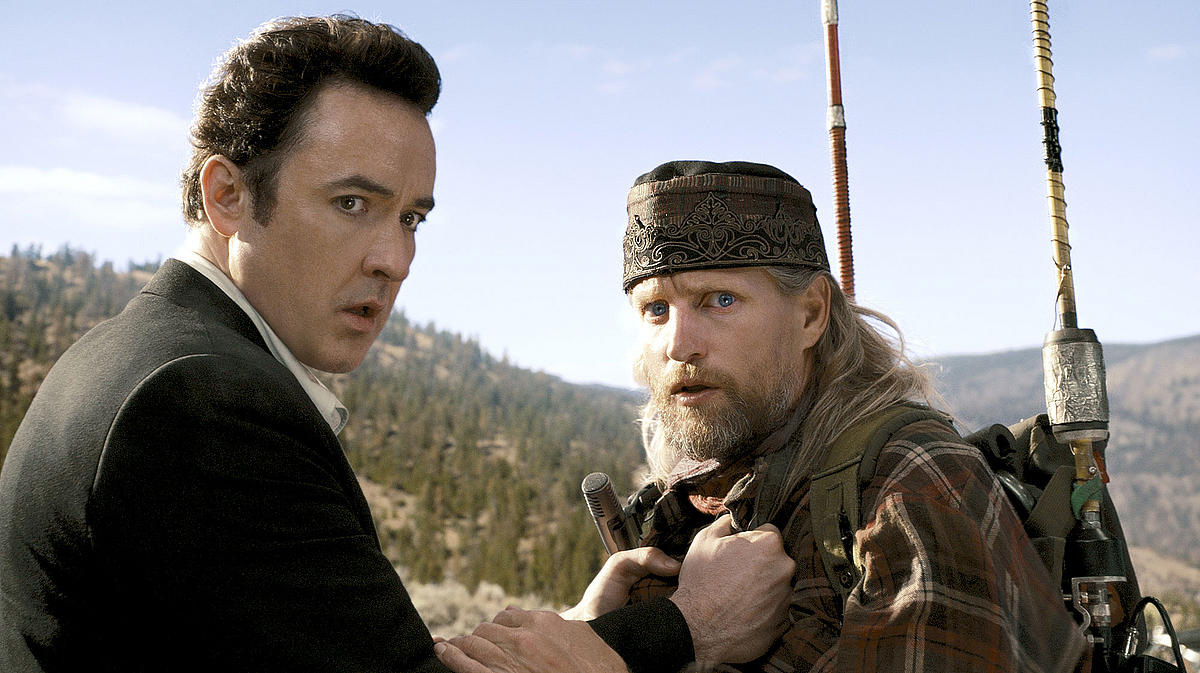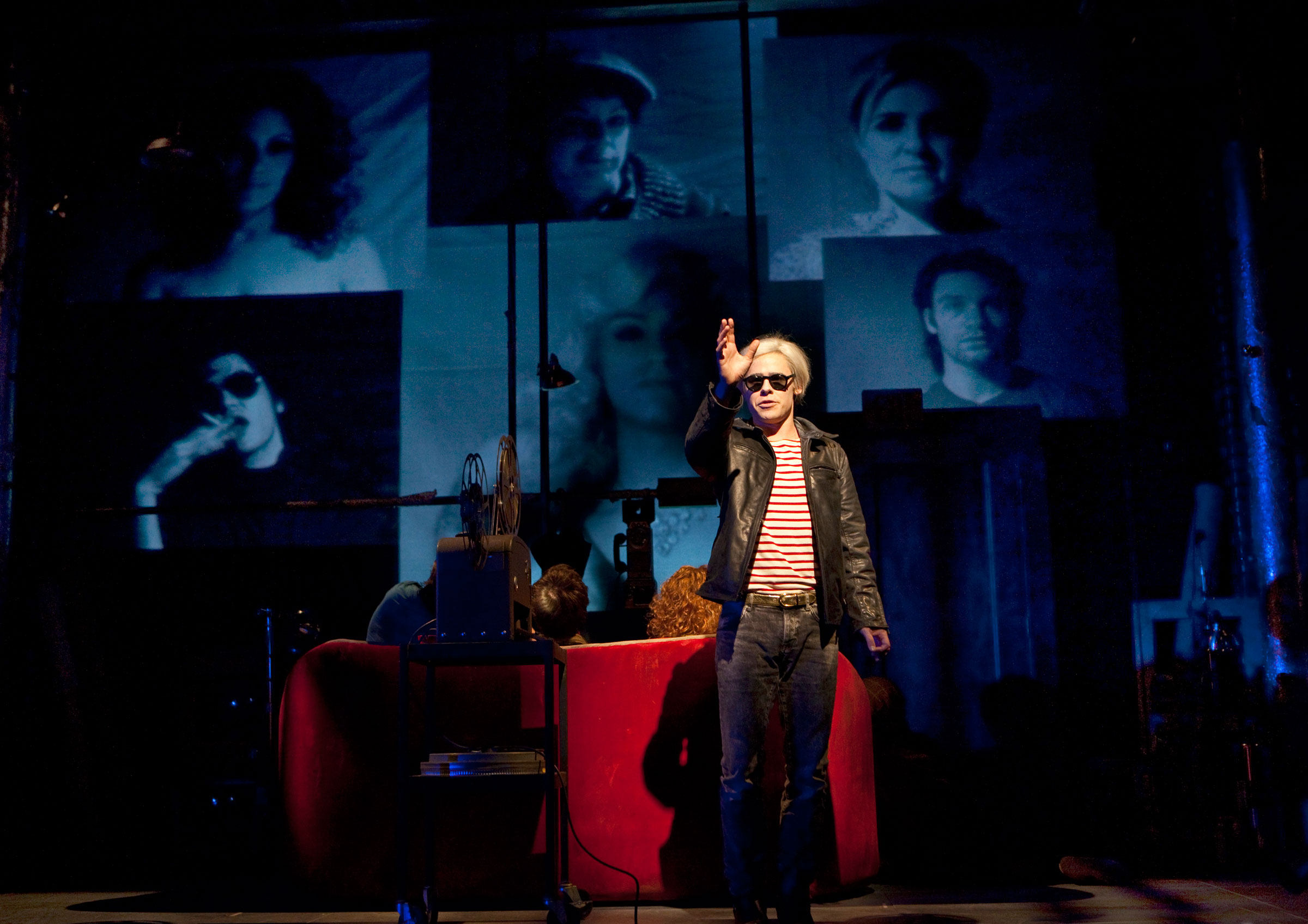 Pop!, the new musical now playing in its world premiere at the Yale Rep, could have been a camp classic: staging a song-and-dance extravaganza on the shooting of famed pop artist, provocateur, and blasé icon Andy Warhol at the hands of a disaffected feminist revolutionary, Valerie Solanis, in 1968. The silver Factory, Warhol’s headquarters at 231 East 47th street in NY, was famed for its stable of hangers-on, including “poor little rich girl” Edie Sedgwick, pre-op transexual Candy Darling, and other would-be geniuses. From this remove, it would be possible to play these characters for laughs, as a collective disgorging of whatever is stored in the closet marked “NYC Underground c. 1967.” Along the way, we might be amused (or not) by the fact that one of these “superstars” had the wherewithal to shoot and critically wound The Master.
Pop!, the new musical now playing in its world premiere at the Yale Rep, could have been a camp classic: staging a song-and-dance extravaganza on the shooting of famed pop artist, provocateur, and blasé icon Andy Warhol at the hands of a disaffected feminist revolutionary, Valerie Solanis, in 1968. The silver Factory, Warhol’s headquarters at 231 East 47th street in NY, was famed for its stable of hangers-on, including “poor little rich girl” Edie Sedgwick, pre-op transexual Candy Darling, and other would-be geniuses. From this remove, it would be possible to play these characters for laughs, as a collective disgorging of whatever is stored in the closet marked “NYC Underground c. 1967.” Along the way, we might be amused (or not) by the fact that one of these “superstars” had the wherewithal to shoot and critically wound The Master.
But Maggie-Kate Coleman, author of the book and lyrics of Pop!, her collaborator, Anna K. Jacobs, composer, and director Mark Brokow are after something else: the play, staged as a kind of dream inquisition into the shooting, occuring in Andy’s mind moments afterwards, eventually becomes an inquisition on Andy himself, as both the shaman and charlatan who created the forces of resentment that would lead to the attempted murder. Not so much: who shot Andy Warhol, and why?, but rather: who wouldn’t shoot Andy Warhol, and why not?
The humor of the piece is wry and ironic in its treatment of Warhol, a coolness that the artist himself might well have appreciated. Randy Harrison is dead-on in his Andy-mimicry, recreating the artist as a likeable apotheosis of a dilettante, always ready to give an empty paper bag to anyone who really needs it. And by giving voice to Andy’s underlings -- most notably in the powerful, engaging, crowd-pleasing performance of Leslie Kritzer as Valerie -- the songs, such as “Up Your Ass” and “Money” and “Big Gun,” chip away at or send up any sympathy we might have for Andy, converting these characters from the ciphers of grime-glam they were in real life, given status by their roles at the Factory and in Andy’s homemade arthouse B movies, into articulate spokespersons for the needs of the uncelebrated, the passed-over, the assistants and groupies, the would-bes of all stripes, and finally, of women as the formerly disenfranchised but now up-and-coming demographic for all things cultural.
Thus, we get the replacement of the Oedipal struggle with artistic "fathers," that the Abstract Expressionists understood, with the anti-partriarchal struggle of the likes of Valerie, whose S.C.U.M. manifesto (Society for Cutting Up Men) envisions a world rid of men in which women will finally achieve their greatness. But as Andy sings at one point “I’m not your father,” and casting him in the role of the evil daddy, or even the fetish-loving gay daddy-substitute, sends out ripples of satire.
The play is entertainingly artful in its mocking of all sides: treating the Ab-Exs Jackson Pollock, Franz Kline, and Robert Motherwell as macho cowboys, much as Warhol and his crowd perceived them, but at the same time mocking Andy as the working-class mama’s boy from Pittsburgh who recreated himself as the holy avatar of making art the mirror in which consumerism can read its own features, fascinated and narcissistic (and Warhol would not see those as negative characteristics), but who, it seems, never really gave of himself. That he attracted a crew of narcissists is another point the play sends up, by never letting us forget that the great talents supposedly possessed by the likes of Viva, Edie, Candy, and Valerie were largely wishful thinking.
It’s also the case that Warhol himself was fallible to just such wishful thinking. He really wanted his movies to be appreciated by Hollywood, to earn him status and a real budget, so that he could really make stars of his “superstars.” But it never happened, and the disappointment, as an aspect of Warhol’s own story -- as, eventually, the hanger-on of all hanger-ons, even to his own magazine and art production, and in his flattered attendance on the beautiful people -- is missing here. Perhaps the play could use a poignant aria by Andy on the pressures of being famous, to offset the sentiments of “15 Minutes” in which the company seems to accept as a mantra Warhol’s observation that “in the future, everyone will be famous for 15 minutes.” He didn’t say it as a promise, but rather as a prediction -- that the search for fame would become the driving feature of life.
The musical, which began life last summer in the Yale Institute for Music Theatre, is still finding its feet. It’s a lot of fun and could become a hit in New York. If it gets the Broadway treatment it could use some real dance routines to flesh out the Factory -- the cast of seven are all quite good as singers, but display rhythmic movement more than actual dance numbers. The stage and cast are small, but if both expand, more could be done with some of the songs as production numbers.
Special mention should be made of Brian Charles Rooney as Candy, who sings at times like a woman, at times like a man, and at times like a man singing like a woman, depending on what is required; as our Mistress of Ceremonies, Candy’s role is pivotal and, it seems to me, could benefit from more play as a glamour queen -- the bridge between Judy Garland and David Bowie, as it were, a new Sally Bowles for a different time.
For me, the weak links are the guys -- Ondine (Doug Kreeger) and Gerard (Danny Binstock), two Factory workers who are given roles as stoned sleuths -- whose songs never quite come alive. Unlike the girls, each of whom gets a song outlining her particular status. But even there, Edie’s songs were largely lacking in the bite and wit given to Valerie and Viva (Emily Swallow); Edie (Cristen Paige), in the Factory mythology, was more than simply a victim of wealth or a would-be starlet looking to be cast in a major role -- her own life -- by Andy. For a time she was a sort of androgynous double for Warhol in those early days when her name opened more doors than his did.
One has the sense that the musical could expand too in its cameo roles -- where’s Billy Name? Why not a bit for Lou Reed (“I have some resentments that can never be unmade”) as potential assassin? More, more, more. As Andy himself said, “always leave them wanting less.”
POP!
Book and lyrics by MAGGIE-KATE COLEMAN
Music by ANNA K. JACOBS
Directed by MARK BROKAW
November 27-December 19, 2009
Yale Repertory Theatre
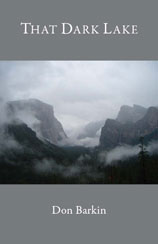 Review of That Dark Lake
by Don Barkin
Antrim House, $19
Review of That Dark Lake
by Don Barkin
Antrim House, $19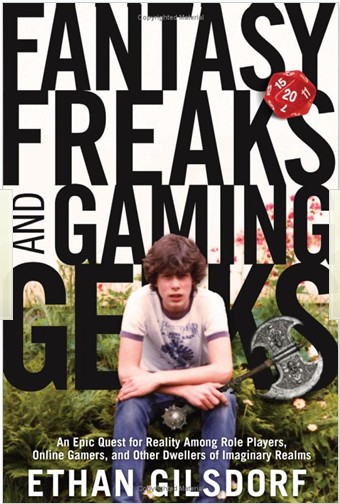

 Meyer Levin, a writer best-known for his novel Compulsion, the story of the Leopold-Loeb murder and trial, wanted to be known as the man who wrote a play based on the diary of Anne Frank. He met with Otto Frank to discuss that possibility before Anne’s book had even been published in the U.S.
Meyer Levin, a writer best-known for his novel Compulsion, the story of the Leopold-Loeb murder and trial, wanted to be known as the man who wrote a play based on the diary of Anne Frank. He met with Otto Frank to discuss that possibility before Anne’s book had even been published in the U.S.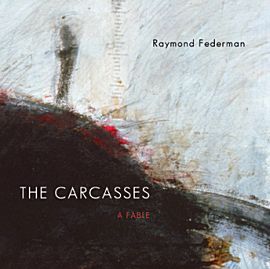
 Reading Charlotte Garrett Currier’s Shadow and Light: A Retrospective left me conflicted: Had Ijust finished a book of poetry or listened to a Charles Auguste De Beriot movement? Currier incontestably has a vigilant ear for the metrical line unit, creating impeccable rhythms, balancing the traditional formalities of meter and rhyme scheme. Her work is a unique, eye-pleasing integration of extant linguistic idiosyncrasies with avant-garde typography. Perhaps it is fortuitous that I do not have to answer my question of whether Currier writes poetry or composes music. As Dylan Thomas once offered, “Poetry is what makes me laugh or cry or yawn, what makes my toenails twinkle, what makes me want to do this or that or nothing.” At heart, the intent of poetry is to make the audience feel, and feel deeply, and Currier, through this highly metrical almost-memoir, certainly reminds us what it is to wholly feel—whether we wish to be so reminded or not.
Reading Charlotte Garrett Currier’s Shadow and Light: A Retrospective left me conflicted: Had Ijust finished a book of poetry or listened to a Charles Auguste De Beriot movement? Currier incontestably has a vigilant ear for the metrical line unit, creating impeccable rhythms, balancing the traditional formalities of meter and rhyme scheme. Her work is a unique, eye-pleasing integration of extant linguistic idiosyncrasies with avant-garde typography. Perhaps it is fortuitous that I do not have to answer my question of whether Currier writes poetry or composes music. As Dylan Thomas once offered, “Poetry is what makes me laugh or cry or yawn, what makes my toenails twinkle, what makes me want to do this or that or nothing.” At heart, the intent of poetry is to make the audience feel, and feel deeply, and Currier, through this highly metrical almost-memoir, certainly reminds us what it is to wholly feel—whether we wish to be so reminded or not.
 Pop!, the new musical now playing in its world premiere at the Yale Rep, could have been a camp classic: staging a song-and-dance extravaganza on the shooting of famed pop artist, provocateur, and blasé icon Andy Warhol at the hands of a disaffected feminist revolutionary, Valerie Solanis, in 1968. The silver Factory, Warhol’s headquarters at 231 East 47th street in NY, was famed for its stable of hangers-on, including “poor little rich girl” Edie Sedgwick, pre-op transexual Candy Darling, and other would-be geniuses. From this remove, it would be possible to play these characters for laughs, as a collective disgorging of whatever is stored in the closet marked “NYC Underground c. 1967.” Along the way, we might be amused (or not) by the fact that one of these “superstars” had the wherewithal to shoot and critically wound The Master.
Pop!, the new musical now playing in its world premiere at the Yale Rep, could have been a camp classic: staging a song-and-dance extravaganza on the shooting of famed pop artist, provocateur, and blasé icon Andy Warhol at the hands of a disaffected feminist revolutionary, Valerie Solanis, in 1968. The silver Factory, Warhol’s headquarters at 231 East 47th street in NY, was famed for its stable of hangers-on, including “poor little rich girl” Edie Sedgwick, pre-op transexual Candy Darling, and other would-be geniuses. From this remove, it would be possible to play these characters for laughs, as a collective disgorging of whatever is stored in the closet marked “NYC Underground c. 1967.” Along the way, we might be amused (or not) by the fact that one of these “superstars” had the wherewithal to shoot and critically wound The Master.
